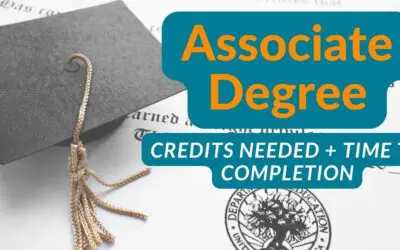An associate’s degree is a two-year undergraduate degree that can be earned at a community college, technical school, or online university. Associate’s degrees are typically focused on a specific area of study, such as business, nursing, or computer science. Many students choose to pursue an associate’s degree because it is less expensive and time-consuming than a four-year bachelor’s degree.
Additionally, an associate degree can provide a solid foundation for further education or for entering the workforce. For example, many students use their associate’s degree as a stepping stone to a bachelor’s degree, while others use it to start their career in a particular field. No matter what your goals are, an associate’s degree can be a great way to get started on your educational journey.
Table of Contents
How many credits for an associates degree in California?
California requires students to complete a minimum of 60 units in order to receive an associate’s degree. 18 of these credits must be related to their chosen major, while the rest may be used as general education classes.
The governing board of a community college district shall confer the associate degree upon a student who has demonstrated competence in reading, in written expression, and in mathematics, and who has satisfactorily completed at least 60 semester units or 90 quarter units of degree-applicable credit course work – 5 CCR § 55063
In addition, students must complete at least 12 units from their major field of study. Students should contact their selected institution’s department or admissions office for additional information on specific degree requirements. Associate degree graduates had to work tremendously hard to improve the prospects of their professional careers.
What are the Different Types of Associates Degrees?
There are two main types of associate degrees: the Associate of Arts (AA) and the Associate of Science (AS). The AA degree is typically offered by community colleges and is designed to prepare students for transfer to a four-year institution. The AS degree is typically offered by technical schools and is designed to prepare students for entry-level careers.

In addition to the AA and AS degrees, there are also a number of specialized associate degrees that are designed for specific careers. For example, many community colleges offer an Associate of Applied Science (AAS) degree in nursing. This degree is typically completed in two years and prepares students to take the licensing exam to become a registered nurse.
Associate of Arts Degree (A.A.)
An Associate of Arts degree is a two-year undergraduate degree that is most commonly awarded in the liberal arts. Students earning an associate’s certification can complete general education courses as well as courses related to their major area of study. Many students choose to pursue an A.A. degree before transferring to a four-year university to complete a bachelor’s degree.
The credits earned while completing an A.A. degree often transfer to a four-year institution, saving time and money. There are many different majors that can be completed through an AA program, such as English, history, sociology, psychology, music, and economics. Although an AA degree typically takes two years to complete, some students may be able to finish in less time, depending on their prior coursework and credit transfers.
Associate of Science Degree (A.S.)
The Associate of Science (A.S.) degree is a popular type of associate degree, most commonly earned after two years of full-time study. Programs typically include science and math studies and general education courses, providing a solid foundation for students who wish to continue their education by earning a bachelor’s degree.
Specific areas of focus for A.S. degrees vary widely but may include fields such as chemistry, biology, engineering, business administration, or computer science.
Because an A.S. degree generally requires roughly 60 credit hours to complete, it typically takes about two years to earn this credential.
For students who wish to enter the workforce immediately after graduation, an A.S. degree can provide the necessary skills and knowledge for many entry-level positions in various industries.
For example, one popular associate’s program is a dental hygienist certification. People enjoy taking this route because they know that it is a job that has to be specialized and requires the attention of all technicians.
It is an opportunity for someone to take courses that they know will translate into real-world opportunities in the job market.
Associate of Applied Science (A.A.S.)
Associate of Applied Science (A.A.S.) degree programs are designed to prepare students for the workforce – or, as some may call it, “the real world.” An A.A.S. degree is a two-year degree designed to prepare students for a career in a specific field.
A.A.S. programs generally require students to complete fewer hours of general education coursework than traditional four-year programs. There are many A.A.S. degrees, including programs that focus on engineering or business.
Some examples of A.A.S. degrees include:
- Graphic design
- Foodservice management
- Medical Assisting
- Automotive technology
A.A.S. degrees can be beneficial for both recent high school graduates and working professionals who are looking for a career change or promotion. These programs provide students with the skills and knowledge they need to be successful in their chosen field.
What are the Benefits of an Associates Degree?
The benefits associated with an associate’s degree differ depending on the path of the individual. To simplify this point, I will discuss the benefits of an associate’s degree for those who (1) intend to begin working right after acquiring it and (2) those who will go on to transfer to a four-year bachelor’s level program.
Only an Associate Degree
Those who intend to begin working immediately after finishing their associate degree will generally find that the degree has several benefits.
First of all, according to the American Association of Community Colleges, holders of this type of degree can earn up to 23 percent more money than individuals who have not continued their education beyond high school.
Further, completing an associate program may increase one’s employability, as it provides skills and knowledge relevant to one’s chosen career path.
In fact, employers in many fields consider applications only from individuals who have a minimum of an associate qualification.
Students can achieve an associates degree in concentrations that award science degrees, arts degrees, and degrees in other realms of the social sciences.
Make sure you are following the articulation agreement because it is imperative that courses are completed on time to achieve recognition by various bachelor’s level programs.
For example, healthcare jobs, including medical assistant and dental hygienist, typically require at least an associate degree.
Similarly, many technology jobs also require applicants to have an associate’s degree in a relevant field. These are not entry-level jobs and require a number of transferable skills that boost the median annual salary for these skill sets.
Related: The Associate Degree for Transfer: Your Gateway to a Four-Year University
Specific job functions will influence the pathway for an associate degree. Bachelor’s programs are great, but junior college is an important step to further study and evaluation as they have produced a number of registered nurses and health sciences individuals to deliver high-quality patient care.
These students also learned how to utilize applied scientific principles to become qualified criminal justice professionals and dental hygienists.
Finally, those with an associate’s degree may find it easier to transfer to a public or private university should they decide to pursue a higher level of education.
Many colleges and universities offer special programs and services for transfer students with associate degrees. In summary, there are numerous benefits associated with holding an associate’s degree.
Associate Degree for Transfer
An associate degree program can be a great option for students who want to continue their education beyond high school but aren’t ready to commit to a four-year institution.
Junior colleges offer two-year programs that are significantly cheaper than four-year colleges, making them a cost-effective way to complete general education and elective requirements.
In addition, junior colleges often offer evening and weekend classes, making them more convenient for students working or with other commitments. Community colleges are also flexible in how they provide online education; some even offer online associate degrees.
After completing an associate degree program, students can transfer to a four-year college to complete a bachelor’s degree program. This option can save students time and money, as they will have already completed some of the required coursework. Students should also look at any available federal student loans and learn whether students earn financial aid for those few years.

Associate degree programs also offer career opportunities for students who decide not to continue their education. Many technical and vocational programs can lead to successful careers in various fields.
Students should consult with a school counselor to ensure they are taking the necessary courses to transfer to a four-year college if that is their goal.
Lastly, associate degree programs are often completed at local two-year colleges, granting students the option of living at home while enrolled. As a result, students can avoid the high costs of rent and utilities and can focus on saving money and working hard.
Cost-effectively saving money on tuition and saving yourself from economic immobility caused by rampant student loan debt. Further, an associate program allows students who are uncertain whether a bachelor’s degree is right to “test drive” the college experience without making a four-year commitment.
Every school implores a different bachelor’s program that directly impacts the relationship between the school and the student. Schools should want to prioritize students that demonstrate an interest in not only transferring but also in the prospects of achieving various master’s degrees and contributing to the culture that your bachelor’s programs exhibit.
What is the Difference Between an Associate’s Degree and a Bachelor’s Degree?
The main difference between an associate’s degree and a bachelor’s degree is the amount of time it takes to complete each program. An associate’s degree can be earned in as little as two years, while a bachelor’s degree typically takes four years to complete.
In addition, associate programs are usually offered at community colleges and trade schools, while bachelor’s degrees are primarily offered at four-year universities. However, some associate’s programs have affiliated colleges and universities that work with the institution to promote high-paying and well-paying jobs.
These programs typically take longer to complete than traditional associate’s programs, but they can offer students a more seamless transition into a four-year degree program. Ultimately, pursuing an associate’s or bachelor’s degree depends on the student’s educational goals and career aspirations.
How much does Associate Degree Make?
For the average U.S. employee, there’s a considerable advantage to earning a 2-year associate degree.
According to the Bureau of Labor Statistics (BLS), workers with an associate degree had median weekly earnings of $938 in 2020, compared to $781 for those without a high school diploma. Workers with more education generally earn more and may also benefit from greater economic stability throughout their careers.
Associate’s degree holders earn more at the median than those with no more than a high school diploma. Similarly, bachelor’s degree holders typically earn more than those with associate’s degrees.
However, there are some professional fields in which workers with associate degrees can earn just as much as those with bachelor’s degrees.
For example, workers with associate degrees in computer programming and aerospace engineering tend to earn the same as those with bachelor’s degrees in these fields.
In fact, according to one study, Associate’s degree holders working in computer and mathematical occupations have median lifetime earnings of $2.8 million, the same as the median lifetime earnings for all bachelor’s degree holders.





